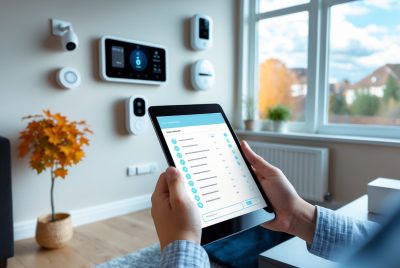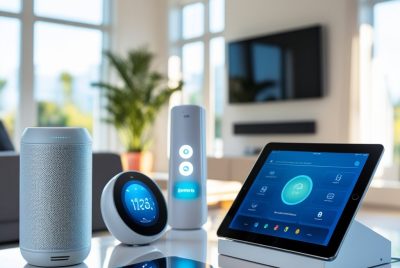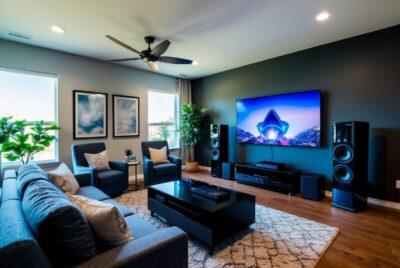Voice Control Smart Home Tips for Seamless Automation
*We may earn a commission for purchases made using our links. Please see our disclosure to learn more.
Voice Control Smart Home Tips for Seamless Automation
Welcome to the Voice Control Smart Home Tips hot topic! Smart homes are getting easier to use thanks to voice control, but getting the most out of these features can sometimes be tricky. With the right approach, I can use simple voice commands to turn on lights, adjust the temperature, and control other devices all around my house.

Knowing a few key tips, like using clear commands, grouping devices by room, and using secure settings, helps me make my smart home safer and easier to manage. When I speak clearly and use the right device names, my voice assistant understands me better and follows my instructions quickly.
If you want to make everyday tasks simpler and cut down on hassle around the house, these voice control tips can save you time and effort. With a little setup and some practice, talking to your home devices feels natural and convenient.
Getting Started With Voice Control

I need to make sure my home is prepared before I start using voice commands. Having the right devices, setting up a voice assistant, and connecting everything to a steady Wi-Fi network are all important steps.
Choosing Compatible Devices
I always check if my smart home gadgets will work with my chosen voice assistant. Most popular brands like Amazon Alexa, Google Assistant, and Apple Siri have long lists of supported devices.
Here’s a quick table for reference:
| Voice Assistant | Common Compatible Devices |
| Amazon Alexa | Smart lights, plugs, cameras, locks |
| Google Assistant | Speakers, thermostats, displays |
| Apple Siri (HomeKit) | Thermostats, plugs, lights, cameras |
I also look for official logos like “Works with Alexa” or “Google Assistant Compatible” on product boxes or online listings. This helps guarantee smooth setup and use.
It’s best to use devices from well-known brands, since they often get more updates and support. I avoid mixing too many brands at once, as that can make setup harder.
Setting Up Voice Assistants
First, I download the right app for my voice assistant. For Alexa, I use the Amazon Alexa app. For Google Assistant, I need the Google Home app. Apple devices need the Home app.
After logging in, I follow the in-app steps to connect my smart devices. Many apps have clear guides and usually find devices on my Wi-Fi automatically.
I give each device a simple name, like “Bedroom Light” or “Kitchen Speaker.” This makes voice commands work more smoothly. I might also create groups or rooms, such as “Living Room,” so I can control many devices with one command.
A key tip is to keep my phone or tablet nearby during setup. Most voice assistants use these devices to scan for and add new products.
Configuring Wireless Networks
My voice-controlled devices need to be connected to my home Wi-Fi to work. I always check that my Wi-Fi signal is strong in every room where I’ll put devices.
Here are a few tips I follow:
- Use a single Wi-Fi network name (SSID) across my home to avoid confusion.
- Make sure my Wi-Fi router supports at least 2.4 GHz, as some smart devices only work on this band.
- Keep network passwords simple but secure, so I can enter them easily during setup.
If I use many smart devices, I sometimes upgrade to a mesh Wi-Fi system. This gives stronger signal coverage and helps prevent connection drops. I also check for firmware updates for my router, as this can fix bugs and security risks.
Optimizing Voice Commands

Making voice control simple and reliable helps me get more out of my smart home. I focus on customizing my commands, organizing devices into logical groups, and scheduling routines for daily convenience.
Creating Custom Phrases
I create custom voice commands to match my daily habits. Instead of using default phrases from the smart assistant, I set up short sentences that feel natural to me. This makes it faster to control devices, especially with tasks I do often.
For example, I might set “Goodnight” to lock the doors, turn off the lights, and lower the thermostat, all at once. With custom phrases, I avoid repeating long or awkward sentences. Most smart home systems, like Alexa and Google Assistant, allow me to set these shortcuts in their apps.
Short and easy-to-remember phrases work best. I avoid words that sound alike or can be misunderstood. This reduces errors and helps the voice assistant understand my requests the first time I say them.
Grouping Devices for Simplicity
To keep my commands simple, I group devices by room or activity. Instead of saying “Turn off the bedroom lamp and the nightstand light,” I group both under “Bedroom lights.” Then, I can turn off all the lights in one room with a single command.
This method works well for lights, fans, outlets, or even speakers. In the app, I usually drag and drop devices into groups, then name the group something clear. Setting up device groups makes the smart home quicker to control, and I spend less time managing each device one by one.
I also use groups for whole-home actions like “All lights off” or “Downstairs on.” This just takes a minute to set up, but it makes my voice control much more efficient every day.
Automating Routines With Schedules
I automate routines to have my smart home run by itself at set times. For example, I schedule the living room lights to turn on at sunset. In the morning, I use routines that open my blinds and start the coffee maker when I say “Good morning.”
Most smart assistants let me assign schedules using simple menus or by asking, “Set a routine for 7 AM.” I pick actions, set the time, and choose a trigger phrase if I want it to start by voice too. Here’s a table of popular routine ideas:
| Routine | Trigger Time | Actions |
| Wake Up | 7:00 AM | Lights on, coffee maker on |
| Leaving Home | 8:00 AM | All lights off, door locked |
| Bedtime | 10:00 PM | Lights off, thermostat lowered |
This kind of automation makes my smart home reliable, even if I forget to say a command. I can always stop or change routines later if my schedule changes.
Enhancing Security and Privacy

When I use voice control in my smart home, I focus on keeping my data safe and making sure only trusted people can access my devices. Handling device permissions, securing my accounts, and enabling voice recognition are three important ways I improve security.
Managing Device Permissions
I always check which apps and devices have access to my smart home system. It is important to review permissions for each device or service I connect. Unused devices or apps should lose access right away.
I keep a list of connected devices and apps, updating it when I add or remove gadgets. This helps me spot anything unfamiliar or risky. I also check settings on each voice assistant app, such as those from Amazon Alexa or Google Assistant, and turn off features I don’t use.
Tips for permissions:
- Only allow trusted apps to connect
- Remove old or suspicious devices
- Limit permissions to necessary features
Managing these permissions lowers the chance of privacy problems. I avoid giving broad access when I can use more specific permission settings.
Voice Control Smart Home Tips: Securing Account Access
My accounts for smart home devices need strong, unique passwords. I don’t reuse passwords from other accounts. I use a password manager to keep track of them.
I enable two-factor authentication (2FA) when it’s available. This extra step asks for a code sent to my phone or an authentication app before anyone can log in. It makes it much harder for someone else to break into my account, even with my password.
I update my software and apps often. Manufacturers release updates that fix security flaws. If I get a notification about a new update, I install it soon after.
Checklist for stronger account security:
| Step | Completed? |
|---|---|
| Use unique passwords | Yes/No |
| Enable two-factor authentication | Yes/No |
| Update devices and apps regularly | Yes/No |
Utilizing Voice Recognition Features
Voice assistants like Alexa and Google Assistant offer voice match features. I turn these on so my devices only react to my voice or trusted family members’ voices.
I train each device to recognize my voice by following the simple setup in the app. This stops most strangers or guests from controlling my smart home with their voice, even if they are nearby.
When guests visit, I keep the device in guest mode or turn off sensitive voice commands. I review voice activity logs to check if unknown voices tried to use my devices.
Voice recognition tips:
- Set up and update voice profiles
- Limit device access to trusted people
- Turn on guest restrictions when needed
Using voice recognition gives me more control and helps prevent false commands or unauthorized actions in my smart home.
Integrating Advanced Smart Home Features

Making the most of a smart home means combining different systems, customizing controls, and using automation to save time. I keep things simple and set up features that actually improve my daily life.
Voice Control Smart Home Tips: Connecting Multiple Ecosystems
Many smart homes use devices from different brands. To get them working together, I choose a central hub or platform that can link to all major systems, such as Google Assistant, Amazon Alexa, or Apple HomeKit. This saves me from switching between apps or repeating commands.
For example:
| Ecosystem | Example Devices | Compatible Hubs |
| Google Home | Nest, Philips Hue | Google Nest Hub, SmartThings |
| Amazon Alexa | Echo devices, Ring | Echo Show, SmartThings |
| Apple HomeKit | Eve, Nanoleaf | HomePod, Apple TV |
A central hub helps me add new devices and manage them all from one place. Many hubs also allow for voice commands to control different brands at the same time.
Using Scenes for Personalized Control
Scenes combine multiple actions into one command. For example, when I say, “Good Night,” my smart assistant can turn off lights, lock the doors, and set the thermostat.
To set up a scene, I pick which devices I want to include and choose what each one should do. Then, I save the combination as a named scene in my smart home app or hub.
Common scene ideas:
- Morning Routine: Lights brighten, coffee maker turns on, weather is announced.
- Movie Time: Lights dim, blinds close, TV powers on.
- Away Mode: All lights off, alarm system arms, door locks engage.
Scenes help me save time and make my routines much easier to manage.
Enabling Location-Based Automation
Location-based automation, also called geofencing, uses my phone’s location to control devices automatically. When I leave home, I can have the lights, thermostat, and security system adjust themselves without saying a word.
I set up a virtual fence around my home using my smart home app. Once I cross this boundary, certain actions happen based on my preferences. I can:
- Have the garage door close as I drive away.
- Turn on specific lights when I arrive at night.
- Set the thermostat to save energy when nobody is home.
This feature adds convenience and helps me manage my home more efficiently every day.
Voice Control Smart Home Tips: Troubleshooting Voice Control Issues

Sometimes, voice control does not work as expected. Devices may fail to connect or not respond at all, which can be frustrating. I find these problems are usually easy to solve with clear steps.
Voice Control Smart Home Tips: Resolving Connectivity Problems
When my smart home devices are not responding, I first check my Wi-Fi network. Voice assistants and smart gadgets must use the same network; otherwise, they cannot communicate. A quick way to check is to look at your device settings and confirm both are on the same Wi-Fi name or SSID.
If the internet connection drops or is slow, voice commands may not go through. I restart my router and devices—this often fixes connection errors. It also helps to move my smart speakers or hubs closer to the router if I notice weak signals. For more stubborn problems, I check if there are updates available for my devices. Manufacturers release these updates to fix bugs and improve performance.
Here’s a simple checklist I use:
| Step | Action |
|---|---|
| Network Check | Ensure same Wi-Fi for all devices |
| Restart | Power cycle router and devices |
| Update | Download and install latest software |
| Placement | Move devices closer to router |
Addressing Unresponsive Devices
If a device ignores my voice or cannot understand commands, clarity is key. I speak slowly and use simple commands. Sometimes, noise in the room makes it hard for voice assistants to hear. I reduce background sounds, like turning off the TV, and make sure I am close enough to the device.
If commands still fail, I look for physical issues. Some devices have microphone mute buttons; I check if these are turned off. I also make sure the device is plugged in and powered. If it uses batteries, a quick swap often helps.
Resetting the device to factory settings can help as a last resort. I pair the device again with my voice assistant and test if it is now working. If all else fails, I contact customer support using the details in my device’s manual.
Voice Control Smart Home Tips: Frequently Asked Questions
I often get asked about voice commands, device compatibility, and the way different smart assistants work. These answers cover the basics of using, improving, and troubleshooting voice control for smart homes.
1. What are the most useful voice commands for controlling a smart home?
Some helpful voice commands include “Turn on the living room lights,” “Set the thermostat to 70 degrees,” and “Lock the front door.” I also use commands to control groups, such as “Turn off all the lights upstairs” or to activate scenes like “Set lights to movie mode.”
2. How can I improve voice recognition accuracy on my smart home devices?
I make sure to speak clearly and wait a brief moment after saying the wake word before giving a command. Placing my smart speakers in quiet, open areas helps reduce background noise. Keeping devices updated with the latest software can also improve accuracy.
3. Which smart home devices offer the best compatibility with voice-controlled assistants?
Many smart bulbs, plugs, and thermostats work well with leading assistants like Alexa, Google Assistant, and Siri. I check device packaging or online product listings to see if they support my preferred voice assistant. Brands like Philips Hue, Ecobee, and LIFX are known for good compatibility.
4. What are the differences between the main voice assistants for smart homes?
Alexa, Google Assistant, and Siri each have unique strengths. Alexa supports a wide range of devices and third-party skills. Google Assistant often gives better answers for general questions and ties in closely with Google services. Siri is best for those deep into the Apple ecosystem.
5. How can I set up local voice control for my smart home without relying on the cloud?
Some smart home systems, like Home Assistant or openHAB, offer local voice processing options. I can use a smart hub with built-in voice control or look for products that advertise “local” control. This setup often requires more technical knowledge but can give me more privacy and faster response times.




